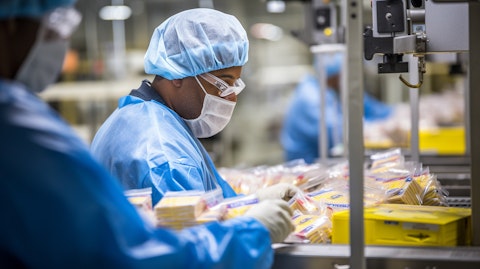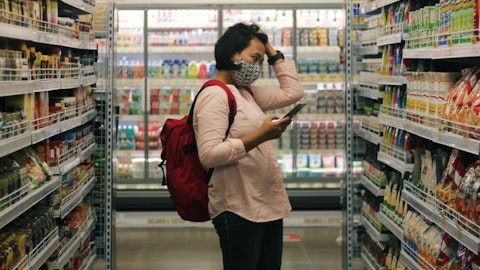General Mills, Inc. (NYSE:GIS) Q2 2024 Earnings Call Transcript December 20, 2023
General Mills, Inc. beats earnings expectations. Reported EPS is $1.25, expectations were $1.16. GIS isn’t one of the 30 most popular stocks among hedge funds at the end of the third quarter (see the details here).
Operator: Greetings and welcome to the General Mills Second Quarter F ‘24 Earnings Call. During the presentation, all participants will be in a listen-only mode. Afterwards, we will conduct a question-and-answer session. [Operator Instructions] As a reminder, this conference is being recorded Wednesday, December 20th, 2023. I would now like to turn the conference over to Jeff Siemon, Vice President for Investor Relations and Treasurer. Please go ahead.

Jeff Siemon: Thank you, Dina, and good morning to everyone. Thank you for joining us this morning for our Q&A session on our second quarter fiscal 2024 results. I hope everyone had time to review our press release, listen to the prepared remarks and view our presentation materials, which were made available this morning on our Investor Relations website. Please note that in our Q&A session this morning, we may make forward-looking statements that are based on our current views and assumptions. Please refer to this morning’s press release for factors that could impact forward-looking statements and for reconciliations of non-GAAP information, which may be discussed on today’s call. I’m here with Jeff Harmening, our Chairman and CEO, and Kofi Bruce, our CFO. So let’s go ahead and get to the first question. Dina, can you please get us started?
See also The 10 Best Telecom Companies to Invest In and 30 Hilarious Classic Prank Call Jokes for Friends.
Q&A Session
Follow General Mills Inc (NYSE:GIS)
Follow General Mills Inc (NYSE:GIS)
Operator: Of course. [Operator Instructions] Our first question is coming from the line of David Palmer with Evercore ISI. Please go ahead.
David Palmer: Thank you. A question on North America Retail margins. They’ve been impressive in spite of the volume declines we’ve been seeing. Do you think that the segment margin can hold near these levels given what’s going on with volume trends? And, I guess, a couple of factors I’m thinking about is, some of your high margin categories, like dough, might be a negative mix effect, but then again, you’re talking about accelerating productivity gains. So, curious about the margins for that segment?
Kofi Bruce: Yeah. David, thanks for the question. Just to rewind a bit, we’ve seen the margin improvement, to your point, largely on the backs of really strong HMM delivery. So, one of the features of this environment has been sort of the stabilization of the supply chain environment, which has allowed us to step up HMM more acutely on this business than our other segments, and also to get at some of those disruption related costs. We’ve made really strong margin progression gains on this business on the backs of those two things. I expect that to abate a bit here as we move forward, just as a result of having already gotten out a good chunk of those disruption related costs. So, on balance, I see this business poised for more stability in aggregate.
David Palmer: And then with regard to the pet business, maybe, is there a comment you want to make there about what the biggest fix will be from here? Wilderness, for example, has been relatively weak, but what do you think the best earliest fixes will be for that business? And what are some of the long-term things you’re looking to do to improve the trajectory? Thanks.
Jeff Harmening: Yeah. Thanks, David. This is Jeff. I would say in the presentation we shared four things we’re working on and a couple of the things we know that we can improve upon to improve the profile of the business. And two of them where we feel good about, and that’s important, because it shows that the Blue brand is still strong. And so, as we look at Life Protection Formula, we’ve changed our advertising on that, and the business has responded nicely, and we’ve seen steady improvements there. We have changed the merchandising on our Treats business, and while it’s not all the way to bright, we’ve seen significant improvement throughout the second quarter on that business, and yet the results are still not what we want to be.
And so that leads to what needs to come next. And I think there are really a couple of businesses that we need to improve. One is our wet business and our wet pet food. And so, you’ll see us introduce some value and variety packs in the back half of the year starting in January, and that — we’d like to see improvements in that. And then the biggest fixes, which will take a little bit longer and they’re kind of interlinked, but they’re not the same. One is Wilderness, and we really need to reposition the Wilderness brand and do some work on that, and that’ll take a little while to get back to full health. The other is that, we have — the pet specialty channel in itself has not done particularly well. We over-indexed in that channel, and there are some things we can probably do to perform better in that channel, even while we keep investing to grow our food, drug and mass channel, which we’re quite pleased with the results and online with the results.
The other thing I guess I would add is, we did have — as we look at the back half of the year, the reason we’re not saying recovery or stabilization is that, in the back half, we had shipments ahead of sales last year and so we’re lapping. That’s particularly true in the third quarter. And so, even to the extent we see some stabilization in the sales trends in pet, the reported net sales are going to lag that because of some inventory build in the back half of the year. So, those are the things that we need to do. Some of them are underway, and we like what we see so far. And there are a couple more that we really need to work on. It’ll take a little bit longer.
David Palmer: Thank you.
Operator: Our next question is coming from the line of Andrew Lazar with Barclays. Please go ahead.
Andrew Lazar: Great. Thanks so much. Good morning, everybody.
Jeff Harmening: Good morning.
Andrew Lazar: And, Jeff, I wanted to maybe chat a bit about — I realize as you’ve talked about in the prepared remarks, the company has some EPS flexibility despite the weaker sales in the form of lower sort of compensation expense versus last year. The HMM, that’s been stepped up, some more share repurchase versus your sort of initial expectations. So, I guess, my question is, is 2024 a year where maybe the company perhaps should lean in even more and maybe be a little less concerned about sort of a specific EPS range, if you will, in order to set it up — set the company up for more sustainable sort of growth in 2025 and beyond? That’s a question I’m sort of getting a lot this morning, so I just wanted to get your thoughts on that if I could.




